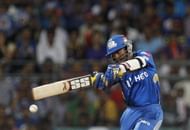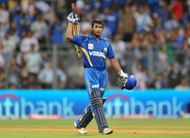The path ahead in the Champions League T20 2013 is not exactly rosy for Mumbai Indians, and no, it is not only because they miss Lasith Malinga.
The situation does not require this article to explain why a T20 outfit will feel the absence of the most lethal death bowler in the world. Rather, their problem is being caught in a cobweb, one which has an escape route, but not from MI’s perspective.
Though we are free to discuss the solution and why MI cannot implement the same. As a result of the aforementioned impasse, they can get themselves stuck in.
MI are most likely to be reduced to damage control mode, one which they may not execute properly too. The article will discuss in detail about the obstacles that Mumbai Indians can possibly encounter in the CLT20 and why they will be facing a catch-22 in trying to overcome them.
Areas of concern:
1. Contrary to the common belief, Dinesh Karthik did not have an exceptional IPL 6. He just enjoyed a great start to the IPL and fizzled out. It is best illustrated by the fact that the wicketkeeper-batsman scored 224 runs in his first four matches as against 286 runs in his next 14 matches.
It is not just about the last IPL, for whoever follows Indian cricket will know how quickly DK can turn from being an exemplary batsman to a mediocre one. After the back-to-back centuries in Champions Trophy 2013 warm-ups, that cemented his place in the Indian team, nothing of note has followed.
Since his comeback to the ODIs, he has scored 255 runs in 12 innings at an average of 31.87 and strike-rate of 70.44. I would not be surprised if he gets the axe any time soon.
2. I am pretty sure no one needs an explanation about Sachin Tendulkar’s struggles of late.
3. Between the two, lies Dwayne Smith sandwiched. Irrefutably, the West Indian deserves a spot based on his exploits in the last IPL (418 runs at an average of 32.15).
But his explosive batting style and increasingly overt weakness against spin bowling mean he is a much better bet with two in-form and dependable batsmen in the middle, than with Sachin Tendulkar, whose powers are waning, and Dinesh Karthik, a double-edged sword.
Hence, Mumbai Indians run the risk of lining up a top three with absolutely no degree of assurance. In a tournament with a much shorter duration as compared to IPL, there is no coming back once you lose your way during the opening gambit.
Lasith Malinga – More than what meets the eye!
Adding to all the above mentioned hindrances, Malinga will not be a part of Mumbai Indians’ campaign.
What shows his value the most is that despite not being at his menacing best in the last edition of the IPL, he still managed to pick up 20 wickets in 17 matches at an economy rate of 7.16 as against Mitchell Johnson’s 24 scalps in as many matches at an economy rate of 7.17.
Malinga’s absence will not only leave MI a bowler short, but also blow the cover of both Harbhajan Singh and Pragyan Ojha, both of whom will now be played according to their merit.
Johnson’s rich vein of form and Malinga’s ever present threat did play a part in the minds of batsmen last season who were forced to take undue risks against the MI spinners, perceiving them to be the weakest spot.
The urge from the batsmen to attack, elicited a number of ill-timed shots that gifted the wickets to the spinners, who picked up 40 wickets between them, despite not playing in spinner friendly conditions. They would not be enjoying the same advantage this time around though.
Destruction of Ambati Rayudu – the T20 cricketer:
Ambati Rayudu started off IPL6 batting at number five and was demoted to number 6 after the first couple of matches, in favour of Kieron Pollard.
A T20 batsman of Rayudu’s breed cannot do much coming in at number 5. I do rate him highly, but he has to be used at a position which suits him in order to draw the maximum output from the Hyderabadi batsman.
In fact, that is the way most batsmen are, not everyone is Brad Hodge (His role with Rajasthan Royals is one of the boldest tactical moves of late I have ever seen, although I don’t agree with it. Hodge has delivered for his team time and again coming in at number 5 or 6 as compared to his usual position in top 3 for all the other T20 teams he has been a part of) or say, quite obviously, AB de Villiers.
Coming back to Rayudu, his strengths lie in taking on the spinners and making the opposition captain think twice before bringing a slow bowler into the attack, besides anchoring the innings. I have no idea how these qualities would be of any use coming in at number 5 in T20s. And when he gets to face more deliveries, he will most probably be resurrecting an innings that has lost its direction.
Needless to say, a big misfit he will be at number six, where, as a batsman, the probability of facing even 10 deliveries is reduced, leave alone the probability of facing spinners and anchoring an innings. It is not a surprise that his returns were so poor last season – 265 runs in 17 innings at an average of 18.92 and a strike-rate of 114.71.
While Pollard reaped huge benefits as a result of his promotion, scoring 420 runs in 18 innings as against his returns of 273, 146 and 220 in his previous three seasons with MI, Rayudu’s 265 at an appalling strike rate was a downward trend as against 356, 395 and 333 in his previous three outings in IPL.
If a strategy paves way for one of your players to reap the rewards, no matter how big a player he is, and completely nullifies the effect of another equally valuable player, it simply can’t be right.
This move was actually facilitated to accommodate Dinesh Karthik at number 3 which makes Rayudu the ultimate scapegoat (not to forget, dumping the wicketkeeping duties on him the season before) to fit MI’s requirements.
The Glenn Maxwell goof up:
So, considering all the above possible barriers they are set to face in this CLT20, Mumbai Indians’ season hopes can either boom or bust depending on how effectively they employ their batting resources and whom they chose to replace Malinga with.
I am quite surprised to see that Nathan Coulter-Nile is not even in contention for the spot. Almost everyone is talking about Glenn Maxwell filling in. Although Maxwell is quite a valuable asset in this format of the game and on the type of pitches CLT20 is about to be played on (expect them to be conducive to batting and support, if any, will be available to fast bowlers in the powerplay overs).
But how does that even matter when he does not come into play at all? Maxwell will be slotted in at number 7, as certainly even by Mumbai’s standards, they will not be activating the scapegoat option again to demote Rayudu further. If they do, why have him at all?
It leaves them with the possibility of wasting two of their batsmen who could have greater impact when used the right way.
The Nathan Coulter-Nile quick fix:
Yes, you read it right. I concede, it’s just a quick fix. After all, I did not select the team that could land MI in all sorts of troubles. So a stopgap measure is the best solution they have for now.
Surely, no bowler in the world could fill Malinga’s spot in T20s but that doesn’t mean you don’t try strengthening your bowling department at all.
The Western Australia fast bowler, Nathan Coulter-nile, though nowhere close to the Sri Lankan in terms of consistency, is known for his death bowling skills. With the ability to make use of life, if any, on the pitch in addition to his big hitting skills, he earns his spot in the playing XI ahead of Maxwell.
He will also give the much needed protection for Mumbai Indians’ spinners and leave batsmen in a state of dilemma of whether to attack or play the spin duo according to their merit.
Thereby, the bowling line up is much more balanced than say Johnson, Harbhajan and Ojha with Abu Nechim, Rishi Dhawan, Pollard and Maxwell. You are looking at a total of 200 runs there, don’t you? Not to forget, Johnson is not known for his death bowling skills either.
Coulter-Nile, who has already made his debut for Australia in T20s and ODIs, could prove to be erratic at times but is on any day a better option than Abu Nechim and Rishi Dhawan in combination with Johnson at death and with the variety in the bowling MI boast of, the fast bowler could easily thrive without any real pressure on him.
The dead end:
My solution to all these would be to drop Sachin Tendulkar and that is exactly why MI will meet a dead end in attempting to solve any dilemma that they are about to come across, as they would not even consider the idea of dropping him.
No, it’s not like the entire objective of this article is to end this way, to force Sachin out. But that is the way forward and the only exit route that can unlace all these knots in MI line up unfortunately.
By dropping Tendulkar, Rayudu can be promoted to open along with Smith. Let Rohit Sharma and DK interchange their positions. Rohit at number 3 gives more certainty than DK.
I know that Rohit and the word ‘certainty’ are generally considered as oxymorons, but this is a domestic T20 tournament – one which he definitely has an impressive track record to support this move, being the second highest run-scorer in the history of IPL, behind only to Suresh Raina.
Leave Pollard in a position from which he can inflict the maximum damage i.e. number 5, for a change I agree with MI on this. Include Aditya Tare in the line up ahead of Sachin and use him as a floater. If a wicket falls early, send him in at number 3, or else just delay him and continue with a top 5 consisting of Rayudu, Smith, Rohit, DK, Pollard.
Unless and until a team can get players who slot in at positions from 1 to 6 automatically, employing floaters is more effective than diluting the batting order.
So considering all the above, here is how Mumbai playing XI should look like – Dwayne Smith, Ambati Rayudu, Rohit Sharma, Dinesh Karthik, Kieron Pollard, Aditya Tare (as floater), Nathan Coulter-Nile, Harbhajan Singh, Mitchell Johnson, Pragyan Ojha, Abu Nechim.
Verdict:
Group stage exit looms large, if Glenn Maxwell is picked ahead of Nathan Coulter-Nile.
Get real-time updates on IPL 2025, live scores, IPL Prediction, match schedule, points table,Result & squad -CSK, MI, RCB, KKR, SRH, LSG, DC, GT, PBKS



